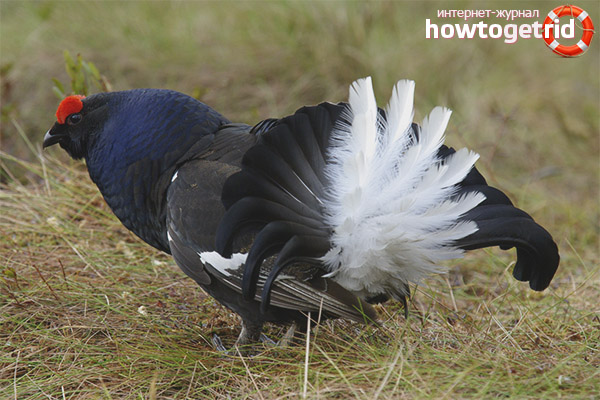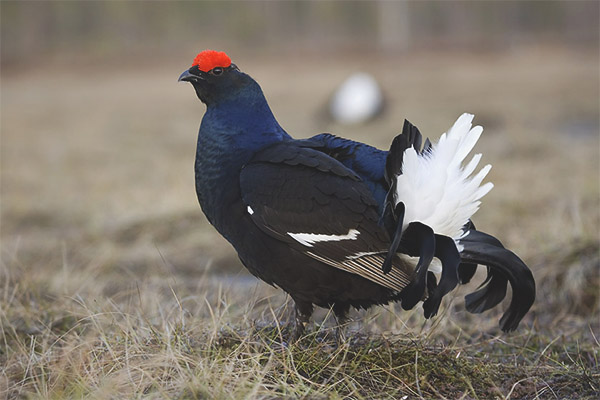The content of the article
Grouse-kosach is a species of birds with extensive distribution, it is ranked as a family of pheasant. It is a large-sized bird belonging to the order of the chicken. The black grouse prefers to live mainly in forests, but it is also found in steppes and forest-steppe belts. On the Eurasian continent, the largest populations of this bird are in Russia, but it is also found in the provinces of China, located in the north-east of the country. Another black grouse can be seen in the western part of Mongolia, as well as in the north of Kazakhstan.
In its genus, the black grouse forms its own species, whose representatives are found in the northern part of Britain and on the Scandinavian Peninsula. In the European part of the continent, the black grouse-Kosach can be found throughout the European part of the Russian Federation, excluding only the Caucasus.In addition to Belarus and the Baltic States, where Kosach is found in abundance, it can be found on the territory of Poland and Ukraine, as well as in Germany.
External characteristics
The female, whose length reaches 45 centimeters, is much smaller than the male, its weight does not exceed 1100 grams. The male in its length reaches 58 centimeters, and its weight - 1400 grams. These birds have visible signs of sexual dimorphism, which is manifested in the different color of the feather cover of females and males.
The females of this species of bird are called tetter; their plumage looks rather colorful. The brown-brown feathers of these birds are crossed across the stripes, consisting of black, brown and dirty yellow tones. Distinctive arcs over the Tetherok eyes are of little pronounced character, their tail, in comparison with males, has a smaller size and a usual shape.
The young of this species also has a variegated plumage, resembling the coloring of females, but it is somewhat different in the nature of the pattern and color range. On the dress, the spots and stripes of white, black, brown and brown are randomly arranged.
The mating season grouse
The mating season at the grouse begins with the onset of spring. In March, when the first warm rays of the sun begin to warm up the thawed land, on the current of currents - forest edges or open glades, from all sides males gather. The first act of theatrical action begins with the fact that they are seated on the branches of the surrounding trees and begin to emit non-melodious sounds similar to muttering.
With the advent of April, the nature of action on tokovischakh begins to change. The shouts of males become more aggressive, the tension reaches its limit, and the first opponents begin to descend to the ground. Here, below, the case takes a more active character, the males demonstrate their tail plumage to each other, stretch their necks, make intermittent sounds, sometimes flapping their wings, demonstrating their courage. More impudent screamers pursue cowardly rivals without hiding their superiority. The active phase of the clarification of relationships can be interrupted by a sudden deterioration of the weather, but as soon as the sun reappears, actions on tokovisch erupt with a new force.
After some time, females begin to gather for the noise coming from the tokovisch, giving the signal to the males about the beginning of the ritual duels. In style, the confrontation of males resembles cockfights, but with the difference that they are held almost in a contactless form and the losers do not suffer from wounds.
Males of black grouses are characterized by polygamous addictions, they establish relationships with several females at once.Each of them occupies its site on the tokovisch, to which females are invited, and constantly cares about the inviolability of borders.
After mating, the males leave the females, leaving them with all the further hassle associated with the breeding of offspring. The female is engaged in the nest device, incubation and rearing of chicks.
Nesting and rearing chicks

Females construct their nests not far from the former tokovische, scattering over an area of one square kilometer. They make a neat groove in the soil, which is lined with dry grass and covered with feathers. It turns out a round nest, the radius of which is about 20 centimeters. The blacks will carefully camouflage their nests, hiding them in the bushes or in the tall grass under the trees.
From 5 to 13 eggs can be found in a hen's cage, and the incubation period lasts up to 25 days. If the nest was opened by a predator, and the clutch was lost, the female has the ability to lay clutch again, although the number of eggs in this case is halved.Nestlings are born in the second half of June, having dried out for several hours, they rise and do not lag behind the mother. From the night coolness, the hen hides the chicks under the cover of his plumage.
The period of greatest risk for chicks occurs in the first 10 days of their life. This is a hectic time for a caring hen that keeps an eye on its little ones, carefully studying the sounds of the forest. In the event of a predator invasion, she resorts to a well-developed trick - pretending to be wounded, the bird tries to take the stranger as far as possible, and then flies away calmly. Having heard the alarming signal of the mother, the chicks start scattering and freeze, hiding in the grass. When the danger has passed, the brave mother gathers her brood using a new signal.
With the onset of autumn, the tail of males grows to the required length and acquires the characteristic form of the lyre. In nature, the black grouse Kosach lives up to 13 years, it is quite comfortable sedentary, although if necessary it is capable of migrating.
Grouse prefers a vegetarian diet, eating only plant food, but being a chick, willingly eats insects.
Video: Grouse (Lyrurus tetrix)











To send